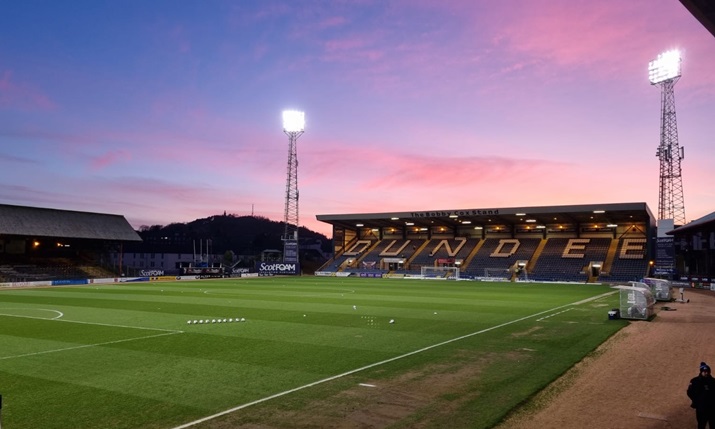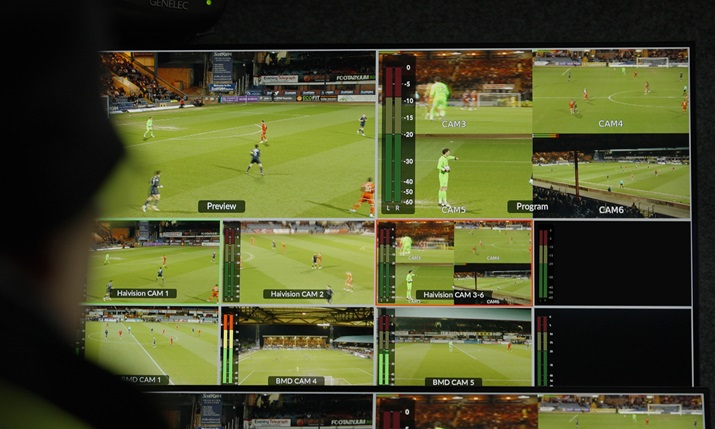
It may not be readily apparent, but in 2024 5G mobile networks are celebrating five years of commercial availability, racking up over 1.5 billion users around the world. From their inception, they have been designed to bring continuous enhancements such as higher data throughputs, massively increased capacity and low latency. Added to these latter qualities have been network slicing and dedicated private networks, capabilities made possible only through standalone 5G (5G SA) infrastructures, writes Joe O’Halloran.
Already, 5G SA is shifting the shape of the broadcast industry by enabling faster, higher quality and more streamlined workflows and redefining remote production. Indeed, 5G SA networks are now enabling remote workflows that are becoming standard in live events of all sizes and importance. As shown during a recent project at Dundee Football Club in March 2024.
“Of critical importance was the video quality of the compressed feeds from the Pro460 encoders delivered over public internet to the QTV MCR, particularly when compared to the SMPTE cabled feeds…feedback was excellent, with quality and synchronisation being suitable for production and broadcast”
Founded in 1893, the Scottish Premier League team has enjoyed modest success on the pitch with solitary Scottish League Division One and Scottish Cup triumphs. However, the team can now boast a major win in 5G SA-broadcasting through a project with 5G networking firm Neutral Wireless and outside broadcast specialist QTV.
The two firms had already worked together in what was said to be a world first for the broadcast industry in the international coverage of the return to London of Queen Elizabeth II after her death in Balmoral, Scotland. For this, QTV deployed a Neutral Wireless private 5G SA network designed to connect cameras and provide a world feed to TV channels globally. This included content captured over a private 5G network deployed for QTV within 24 hours of Neutral Wireless being granted, by UK broadcast and communications regulator Ofcom, a licence for telecoms spectrum in the n77 (3.8-4.2GHz) radio frequency band.
Working under the umbrella of the Tay Cities Region Tay 5G programme, the Dundee project set out to explore and demonstrate the use of private 5G networks for low latency live production workflows in broadcasting Dundee FC’s game against Aberdeen at its Dens Park stadium on 13 March.
The goal was to demonstrate a full wireless production over private 5G, with all the video feeds and expected auxiliary services running on a single network and making use of the bi-directional wireless network to deliver camera control, tally, intercom and return video. While many top-tier sports venues are well provisioned for camera connectivity, the portable wireless multi-camera system proposed by the partners offered advantages for pop-up deployments and stadia such as Dens Park.

As Neutral Wireless began its work, the first step, said Samuel Yoffe, lead engineer for the project, was to look at what type of system was appropriate for the venue and use case.
He said: “Since we specialise in software-defined radio, we biased the network to provide increased uplink connectivity, and with a single network cell we were able to provide coverage anywhere within the stadium with uplink capacity around 250 Mbps,” he explained.
“Where we did work with external partners was in delivering the end-to-end video workflow, from the ultra-low latency video Haivision Pro460 at 100ms to the camera control and tally system [Blackmagic Design] and the Unity Intercom Dante-integrated push-to-talk intercom. Return video feeds could also be returned to the camera through the Streamhub and Pro460 field units.”
As it began to set up, Neutral Wireless arrived the day before the match to rig and test, identifying a suitable location for the cell and verifying uplink capacity at the various camera positions within the stadium. QTV brought two OB vans – one to house the traditional cabled production and a second dedicated to the 5G workflow, with tie lines between the two.
Neutral Wireless also installed a disaggregated Lomond network in a box (NIB), with the n77 radio-head and antenna mounted within the stadium connected by SMPTE cable back to the QTV OB van onsite where a Neutral Wireless Ness portable baseband unit ran the software-defined 5G core and radio stack, with a local user plane where data from 5G-connected devices joined the local area network (LAN).
A Haivision Streamhub server on the user plane took in video feeds over the 5G network and provided SDI outputs into low latency local monitoring equipment as well handing off IP feeds over public Internet to receivers located back at QTV master control room (MCR). Four Blackmagic URSA Broadcast G2 cameras we used for testing, along with an ATEM Television Studio HD8 ISO switcher and Control Panel (RCP). URSA cameras provided 1080p50 video over SDI into the Pro460 video encoders.
The cameras themselves were connected to the network using Apple iPhones as gateways. This allowed an H.264 backup feed to be sent directly from the cameras to the ATEM desk, established the return camera control and tally over IP channel. The RTMP stream used had a latency of about 500ms, which could be reduced to 200ms instead using SRT to a Blackmagic Streaming Bridge.
The iPhones ran the Unity Intercom PTT mobile app, with a local server running on the OB van for low latency. The Unity server interfaced with the OB van intercom systems using Dante and provided intercom from the QTV MCR all the way to the camera operators. Camera control from the OB van using the RCP was responsive, and the RCP was then taken back to the QTV MCR and successfully used to do remote camera control from base.
During the game, Neutral Wireless shadowed the existing SMPTE production to provide a side-by-side comparison of video quality and latency between the identical 5G and cabled feeds for all six Grass Valley cameras. In addition, it ran direct video streams from the four Blackmagic cameras.
As expected with any complex broadcast deployment, Neutral Wireless encountered some initial OB configuration issues in set up as it lacked backhaul internet connection until match day. That said, it was able to test the video-over-5G workflow from camera to the OB van for both the ultra-low latency Pro460 feed and RTMP stream. Other initial challenges included camera control and tally signalling through a simple streaming key configuration error on the ATEM switcher receiving the streams. Once corrected, camera control was established and very responsive.
On match day, and with backhaul internet available , Neutral Wireless was able to finish the full workflow setup with comms and video feeds exchanged with the QTV MCR. Full system tests were then performed and documented, before the second configuration shadowing the wired production was implemented.

In developing the proof-of-concept, Yoffe said the production team learned a lot about the capabilities of the private 5G SA network and how all the services can be implemented. He also believes that it has opened discussion and planning for events in the future that require and a low latency wireless multi-camera OB.
“Of critical importance was the video quality of the compressed feeds from the Pro460 encoders delivered over public internet to the QTV MCR, particularly when compared to the SMPTE cabled feeds,” added Yoffe. “Feedback was excellent, with quality and synchronisation being suitable for production and broadcast.”
At 5G’s five-year mark, video-over-private 5G has now been proven in live contribution across a multitude of live events, from sports, elections, coronations and state funerals. Another thing Yoffe noted was that for the final departure of Queen Elizabeth II from Scotland and during coverage of the subsequent funeral, broadcasters experienced issues broadcasting live with their bonded-cellular devices.
Even though high-latency remote contribution workflow has now been verified, where there was less exposure was the use of private 5G for ultra-low latency production workflows with bi-directional connectivity. Yoffe expressed confidence that the Dundee event demonstrated that full wireless production using a single network and spectrum licence was now feasible.
With the Paris 2024 Games expected to showcase several novel uses of private 5G, Yoffe predicted that the uptake and importance of 5G in the broadcast industry will only increase, and he expects 5G to become commonplace in to augment if not replace cabled and traditional wireless camera links. It’s now very much game on for private 5G.
This post was originally published on the 3rd party mentioned in the title ofthis site




